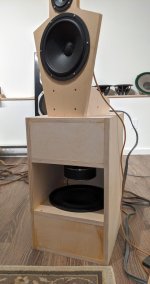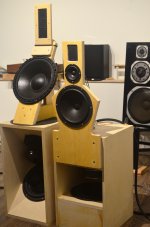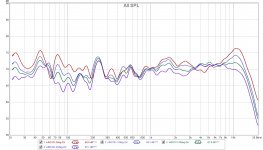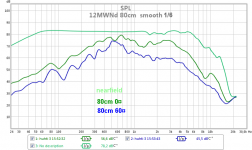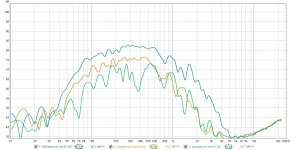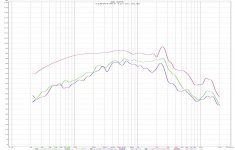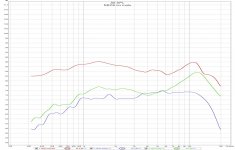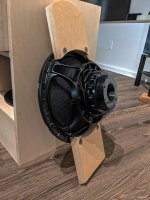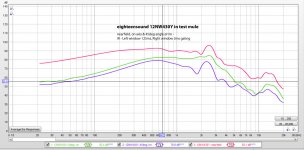 This discussion has been split from this thread Aino gradient - a collaborative speaker project
This discussion has been split from this thread Aino gradient - a collaborative speaker projectThanks for that.Ah, when I met SL in 2013, he naturally encouraged me to do dipole woofers too! LX521 was new then and I also knew of gainphile's work. I said no thanks, I don't have enough room for dipole woofers. And I haven't changed my mind. As well I have a huch that real radiation pattern wouldn't be dipole anyway, 20-200Hz so close to the floor and walls. Wuold that really be any better? I guess I'll never really know...
A friend has double 12" woofers in H frame like SL Orion. They sound good in his room and he plays louder than I. He has set tile bricks on them and cone movement looks really wild, but they don't vibrate much. W frame with 90deg helps a lot for LX521, but vertical slot would be totally force-cancelling. That's what I would make.
Gainphile: S19 4-Way Dipole Radiator
Actually, I think it is indeed dipole into the bass -- haven't measured but walked around with <100Hz tones, and there's a distinct level reduction when listening at the sides of my Orion 3.2 as well as the M-frame dual 10" dipoles I'm experimenting with.
A local buddy who's an active member here agrees with me that there's something special about the sound of dipole bass -- more natural, somehow, than any of other bass loadings, even after all the EQ boost needed to compensate for the dipole cancellation. It just sounds more realistic -- better than serious implementations of ported, twin coupled cavity bass, sealed, aperiodic, TL -- if memory serves correctly. (I haven't heard serious horn-loaded bass; that might be even better.)
Anyway, I've decided to make a pair of Linkwitz / Gainphile W-frame bass boxes. Move the Dayton subs (same ones gainphile used, incidentally) to the new bass bin or try 10" SBAcoustics I've had on hand for ages. (But I haven't given up the idea of cloning your Aino gradient, either. 😉 )
One thing about Gainphile's W-frame: It makes sense to me to keep the volume in the front and back "chambers" about the same, but that's not what he has done; the back-facing openings appear about double the size of the front one. He's obviously happy with it.
In contrast, Linkwitz's dipole sub is much closer to having similar volume in the front & back "chambers".
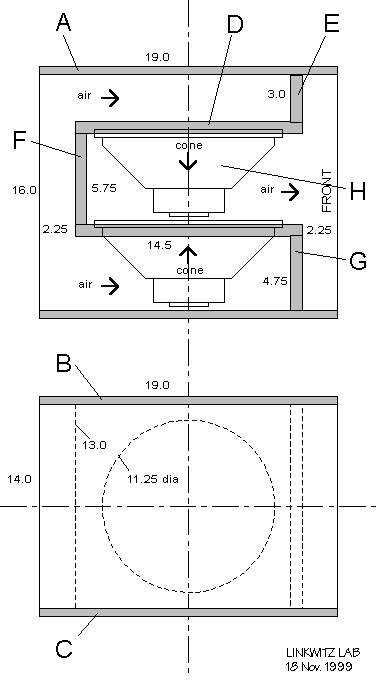
Anyone have any thoughts on this?
Last edited:
In case anyone is interested, I did build a pair of W-config dual woofer open baffle bass frames, much like Gainphile built, with similar dimensions. The dimensions of the 3 chambers are dictated mostly by the need to be able to slide the driver through the chamber into the mounting hole -- if the chamber is too short, you struggle to simply mount the driver.
The end result was dramatically reduced vibration felt all over the "box" when the woofers were worked hard. I had a V-frame on the left and a W-frame on the right, using <100Hz signals in mono. No contest. And the amount of vibration felt in the upper baffle set atop the W-frame was also far less.
No, I did not measure -- there really was no need, it was that obvious.
The end result was dramatically reduced vibration felt all over the "box" when the woofers were worked hard. I had a V-frame on the left and a W-frame on the right, using <100Hz signals in mono. No contest. And the amount of vibration felt in the upper baffle set atop the W-frame was also far less.
No, I did not measure -- there really was no need, it was that obvious.
Attachments
I think Linkwitz did the V frame to reduce the resonance of the cavity - in other words: what it was doing to the freq. response above 100 Hz.
Probably, though he does refer to the more difficult woodwork as a motivation. I did measure a difference between the 2 bass bins at 320~360 Hz. The V-frame's peak was perhaps 5 dB, and broader. The W-frame peaked both higher in amplitude (~8 dB) and narrower. But not that hard to tame with EQ, and there was no audible difference for me with the LP filter for the bass at 100 to 140 Hz LR4.
Aside from the 100% force cancellation, the W-frame box is so much more rigid with walls for the 3 chambers providing natural stiffening of the side panels.
Aside from the 100% force cancellation, the W-frame box is so much more rigid with walls for the 3 chambers providing natural stiffening of the side panels.
Last edited:
Mike, please can you measure just the woofers' response without any eq and xo, 180¤ polars sometime? How high do you estimate dipole pattern goes in freq? Cavity resonances should be well above lowpass anyway, and I suppose dipole peak too.
The thing that puzzles me, is how these dipole woofers work in room placement - on the forr and relatively near to walls. How is the room response and timing? I guess that backwave is louder than frontal, because of front wall reinforcement. Interference peaks sill happen too, depending on distance, but most likely in midrange.
I don't have large woofers available to make a test cab myself, but this puzzles me so much that perhaps I must invest on those next summer...
I see the benefit of monopole woofer like this:
1) Monopole has better efficiency than dipole
2) monopole's front-wall refelction gives boost (same phase polarity) below first reflection null from front wall
In original Gradient 1.3 and AINOs xo is around 150-200Hz, where polar pattern is cardioid and front-wall reflection is mostly eliminated with appropriate distance. With dsp and measurements this can be handled easily. LR2 xo gives wider cardioid range than LR4. 86 cm distance gives first cancellation at 100Hz. A dipole woofer gives a peak at same freq!
HiFi Loudspeaker Design
The thing that puzzles me, is how these dipole woofers work in room placement - on the forr and relatively near to walls. How is the room response and timing? I guess that backwave is louder than frontal, because of front wall reinforcement. Interference peaks sill happen too, depending on distance, but most likely in midrange.
I don't have large woofers available to make a test cab myself, but this puzzles me so much that perhaps I must invest on those next summer...
I see the benefit of monopole woofer like this:
1) Monopole has better efficiency than dipole
2) monopole's front-wall refelction gives boost (same phase polarity) below first reflection null from front wall
In original Gradient 1.3 and AINOs xo is around 150-200Hz, where polar pattern is cardioid and front-wall reflection is mostly eliminated with appropriate distance. With dsp and measurements this can be handled easily. LR2 xo gives wider cardioid range than LR4. 86 cm distance gives first cancellation at 100Hz. A dipole woofer gives a peak at same freq!
HiFi Loudspeaker Design
Last edited:
This is not something I've tried before, I've only done some off axis measurements, not focused on bass frequencies. Can you suggest a guide?Mike, please can you measure just the woofers' response without any eq and xo, 180¤ polars sometime? How high do you estimate dipole pattern goes in freq? Cavity resonances should be well above lowpass anyway, and I suppose dipole peak too.
forr -- floor? Very little reflection off the side walls because of dipole pattern. My speakers are positioned ~1.5m from wall behind speaker. According to HiFi Loudspeaker Design, the quarter & half-length cancellations occur at 57 & 28 Hz. iirc, there are some odd peaks & valleys below 100 Hz that might be explained by this. Will have to double check.The thing that puzzles me, is how these dipole woofers work in room placement - on the forr and relatively near to walls. How is the room response and timing? I guess that backwave is louder than frontal, because of front wall reinforcement. Interference peaks sill happen too, depending on distance, but most likely in midrange.
I don't have large woofers available to make a test cab myself, but this puzzles me so much that perhaps I must invest on those next summer...
I see the benefit of monopole woofer like this:
1) Monopole has better efficiency than dipole
2) monopole's front-wall refelction gives boost (same phase polarity) below first reflection null from front wall
No argument there.
In original Gradient 1.3 and AINOs xo is around 150-200Hz, where polar pattern is cardioid and front-wall reflection is mostly eliminated with appropriate distance. With dsp and measurements this can be handled easily. LR2 xo gives wider cardioid range than LR4. 86 cm distance gives first cancellation at 100Hz. A dipole woofer gives a peak at same freq!
Will check whether measurements on my speakers will confirm these calculations. What distance from speaker do you recommend the mic position?
Forr = floor yes!
Low freq measurements are very difficult to perform. A dipole should be hanging in the air at at least 3m height and mic on ground plane (unless a huge anechoic room is available) dB v2
We amateurs must go with semi-nearfield measurements, but with long IR gating needed we will always catch reflections and room modes too. An extreme nearfield at an inch will not show radiation pattern or dipole roll-off at all.
So, we must use several different measurement techniques and look at response with different gating. Room response at listening spot is one important measurement of course.
Distortion must be measured with outdoor GP techinque, nearfield will overdrive the mic capsule and cause extreme distortion with high spl needed (UMIK breaks to clipping around 130db)
So, I must wit for the summer and hope for sunny days! My guess is that for these 4-way system woofers that are supposed to sit on the floor anyway, good enough measurements can be achieved outdoor on a wide open field, speaker on ground (asphalt or sandfield) and mic on ground at 1-2m distance, spl 85 or 90dB@100Hz/2m. Horizontal polars with a turntable under the speaker. Verticals impossible? Dynamic distortion tests also with 95dB if woofers can handle that.
Low freq measurements are very difficult to perform. A dipole should be hanging in the air at at least 3m height and mic on ground plane (unless a huge anechoic room is available) dB v2
We amateurs must go with semi-nearfield measurements, but with long IR gating needed we will always catch reflections and room modes too. An extreme nearfield at an inch will not show radiation pattern or dipole roll-off at all.
So, we must use several different measurement techniques and look at response with different gating. Room response at listening spot is one important measurement of course.
Distortion must be measured with outdoor GP techinque, nearfield will overdrive the mic capsule and cause extreme distortion with high spl needed (UMIK breaks to clipping around 130db)
So, I must wit for the summer and hope for sunny days! My guess is that for these 4-way system woofers that are supposed to sit on the floor anyway, good enough measurements can be achieved outdoor on a wide open field, speaker on ground (asphalt or sandfield) and mic on ground at 1-2m distance, spl 85 or 90dB@100Hz/2m. Horizontal polars with a turntable under the speaker. Verticals impossible? Dynamic distortion tests also with 95dB if woofers can handle that.
A dipole woofer in a small room is basically just cancelling itself below QW freq limit
Boundary effects
Cardioid bass
And is directivity below Schröder limit of the room of any concern at all? At least at normal listening distance and normal size room.
The Schroeder / Transition Frequency Explained - Acoustic Frontiers
Boundary effects
Cardioid bass
And is directivity below Schröder limit of the room of any concern at all? At least at normal listening distance and normal size room.
The Schroeder / Transition Frequency Explained - Acoustic Frontiers
Haven´t you already measured these old ladies all possible ways human could possibly need?
Only my monopole woofers!
I have been so negative about dipole-woofer for years without really knowing and not having measured them, that I am ashamed of it really. Don't tell others!
What testing?!
😱🙄 You can understand that this is going to be low priority for me, for all the highlighted reasons, right Juha? 😛 Weather is still coldish and wettish. Spring is on the way, our big veg/fruit garden is demanding attention, and I still haven't finalized this design (which I call NaO521s19 😀). Nor have I sorted out details for my version of the Gradient 1.3. I should call it Juha1.3: a 10" Dayton sub in sealed box, open baffle 12" eighteensound, Neo8... and undecided on super tweeter. Neo8 might be enough by itself, high end is pretty extended on axis.Forr = floor yes!
Low freq measurements are very difficult to perform. A dipole should be hanging in the air at at least 3m height and mic on ground plane (unless a huge anechoic room is available) dB v2
We amateurs must go with semi-nearfield measurements, but with long IR gating needed we will always catch reflections and room modes too. An extreme nearfield at an inch will not show radiation pattern or dipole roll-off at all.
So, we must use several different measurement techniques and look at response with different gating. Room response at listening spot is one important measurement of course.
Distortion must be measured with outdoor GP techinque, nearfield will overdrive the mic capsule and cause extreme distortion with high spl needed (UMIK breaks to clipping around 130db)
So, I must wit for the summer and hope for sunny days! My guess is that for these 4-way system woofers that are supposed to sit on the floor anyway, good enough measurements can be achieved outdoor on a wide open field, speaker on ground (asphalt or sandfield) and mic on ground at 1-2m distance, spl 85 or 90dB@100Hz/2m. Horizontal polars with a turntable under the speaker. Verticals impossible? Dynamic distortion tests also with 95dB if woofers can handle that.
So I managed to get the laminated CLD 521-style upper baffle mounted directly on the top front panel of the W-config bass bins. I also got a start on a Aino-Gradient inspired build using a 12" 18sound driver + NEO8 atop dual 10" Dayton 265HF in V-frame open baffle box.
The latter uses 2 small panels, each mounted via 2 bolts and T-nuts to to "top" and "bottom" of the driver frame. These panels are then attached to a L-bracket -- all parts from cutting scraps. It's quite a rigid frame.
The whole speaker is a bit too tall, but 6~8", but it's just a test mule.
Very surprised & pleased at the sound I'm getting from this Aino-G copy, after less than 1 hour of measurements, EQ & Xover work. Bass-to-mid is 250Hz, LR2; mid-to-highs is 800Hz, LR4. In a quick listen to some broadband blues & jazz pieces in mono through JRiver/miniDSP4x10, I'm not really missing the last half octave.
I might prefer the overall presentation of 12" mid + Neo8 to the 3-way of the 8" + 4" Scanspeaks + AST2560 AMT tweeter. But this is an early off-the-cuff reaction. Much more study & a second speaker needed.
The latter uses 2 small panels, each mounted via 2 bolts and T-nuts to to "top" and "bottom" of the driver frame. These panels are then attached to a L-bracket -- all parts from cutting scraps. It's quite a rigid frame.
The whole speaker is a bit too tall, but 6~8", but it's just a test mule.
Very surprised & pleased at the sound I'm getting from this Aino-G copy, after less than 1 hour of measurements, EQ & Xover work. Bass-to-mid is 250Hz, LR2; mid-to-highs is 800Hz, LR4. In a quick listen to some broadband blues & jazz pieces in mono through JRiver/miniDSP4x10, I'm not really missing the last half octave.
I might prefer the overall presentation of 12" mid + Neo8 to the 3-way of the 8" + 4" Scanspeaks + AST2560 AMT tweeter. But this is an early off-the-cuff reaction. Much more study & a second speaker needed.
Attachments
Nice to see these mules - hardcoce of diy!
Bass module measuements lood fine to me (with room-induced peaks)
Neo10 looks like what expected too, dipole directivity lost around 5kHz and onaxis peak at 10kHz
12" mid shows no directivity, strange! Ho you have a guess how come? Do you have individual driver measurements?
I attach my measurements of 12" directivity
Bass module measuements lood fine to me (with room-induced peaks)
Neo10 looks like what expected too, dipole directivity lost around 5kHz and onaxis peak at 10kHz
12" mid shows no directivity, strange! Ho you have a guess how come? Do you have individual driver measurements?
I attach my measurements of 12" directivity
Attachments
Last edited:
Individual driver measurements -- I did, but probably didn't save them. Will run more off today. The 18sound 12" and the Neo8 were very easy to EQ to reasonable smoothness on axis, and the xo I created came together quickly, with the drivers making very good sound just by themselves. Adding the bass bin and making it sound seamless altogether is much harder.
Also played a couple of difficult Linda Rondstadt pieces yesterday and found her overtones nearly screeching. It's typical, her singing voice is very difficult to reproduce without distortion. IIRC, her overtones create IM distortion, especially when she's belting it out. I read somewhere that Ella Fitzgerald had similarly complex overtones. I'm left wondering whether to blame my modest AB amp (Rotel RMB-1048), miniDSP, or the Neo8.
Also played a couple of difficult Linda Rondstadt pieces yesterday and found her overtones nearly screeching. It's typical, her singing voice is very difficult to reproduce without distortion. IIRC, her overtones create IM distortion, especially when she's belting it out. I read somewhere that Ella Fitzgerald had similarly complex overtones. I'm left wondering whether to blame my modest AB amp (Rotel RMB-1048), miniDSP, or the Neo8.
Ok, what IR gating in those graphs? Default 500ms pics up all kinds of reflections, especially for 90deg where direct sound is mostly cancelled.
Linda is my favourite singer! She can alter her voice a lot for different songs - rock, ballad, blues, mexicana, classical etc. Another favourite Eva Cassidy has same talent!
Linda is my favourite singer! She can alter her voice a lot for different songs - rock, ballad, blues, mexicana, classical etc. Another favourite Eva Cassidy has same talent!
A bit more detail of how the 12" driver was mounted. The bottom edge of the bottom wood piece is cut at 30 degrees to replicate the mid-woofer tilt in the Gradient 1.3.
I need to shorten the wood pieces so the tweeter doesn't end up so high. Or get a shorter bass bin. A sealed box with one of those Dayton 10" subs might be coming...
I need to shorten the wood pieces so the tweeter doesn't end up so high. Or get a shorter bass bin. A sealed box with one of those Dayton 10" subs might be coming...
Attachments
IR gating window was set at the default 125 and 500ms. Obviously too long. So what values are suitable for measuring with spkr ~5' from nearest wall?
Room measures 19'W x 22'L with a ceiling that slopes along the length from 9' in the back, to 6' at the wall behind the speakers. It's not ideal, but far cheaper than any other roof/ceiling option when this extension to my workshop was built. The ceiling has 12" rafters 16" apart, the space stuffed with fiberglass, and covered with "50% absorbent" acoustic panels. With the angled ceiling, the fiberglass/acoustic tiles, and a big bass trap that runs along the intersection of the 9' wall and the ceiling, it's fairly well damped -- more than I like, but... everything can't be perfect all the time.
Room measures 19'W x 22'L with a ceiling that slopes along the length from 9' in the back, to 6' at the wall behind the speakers. It's not ideal, but far cheaper than any other roof/ceiling option when this extension to my workshop was built. The ceiling has 12" rafters 16" apart, the space stuffed with fiberglass, and covered with "50% absorbent" acoustic panels. With the angled ceiling, the fiberglass/acoustic tiles, and a big bass trap that runs along the intersection of the 9' wall and the ceiling, it's fairly well damped -- more than I like, but... everything can't be perfect all the time.
OK, I left IR Left Window at 125, Right Window to 3ms. You can tell me if that's too short. The overall effect is to smooth the response -- looking at the previous 500ms curve, obviously there are room effects at 70~80 Hz, ~300 Hz, and 700 Hz. They're much less severe than I expected. 🙂
BTW, there was a local documentary film fest on the weekend, and one film that I watched was Linda Rondstadt: The Sound of My Voice -- Linda Ronstadt: The Sound of My Voice (2019) - IMDb Very good film, learned all kinds of interesting things that made me respect her more. she was totally committed to her art & a real professional. And her singing voice, when she's in fortissimo, is very hard to capture/reproduce cleanly. I have to go back to the house & play her on the Orions to hear if the distortion I hear in the atudio/lab is present there was well.
BTW, there was a local documentary film fest on the weekend, and one film that I watched was Linda Rondstadt: The Sound of My Voice -- Linda Ronstadt: The Sound of My Voice (2019) - IMDb Very good film, learned all kinds of interesting things that made me respect her more. she was totally committed to her art & a real professional. And her singing voice, when she's in fortissimo, is very hard to capture/reproduce cleanly. I have to go back to the house & play her on the Orions to hear if the distortion I hear in the atudio/lab is present there was well.
Attachments
Last edited:
Right window of Impulse Response is what matters. The length determines also how low frequencies will be measured. 3ms will show only above 1kHz right. Check also with 10ms, 20ms, 60ms, 200ms to see the difference!
If you toggle "Impulse" window and and adjust time scale, you will see the main impule peak and reflections after it. Use %FS setting! Then set right window length so that first high reflection peak is not in the analysis time "gate". Gate name sets the steepness of analysis gate.


Loudspeaker measurements
Indoor measurements of low frequencies are difficult just because of time delay of reflections (in impulse response) is so short that long enough gating is not possible.
However by changing the right window time and checking the respective spl/F curve you will learn to recognize the dips and peaks in the response! The relation of magnitude of direct vs. reflected impulse determines how big disturbance it creates in spl response. In %FS analysis sometimes the reflection is higher in magnitude than the first arrival, and then REW sets timing according to the reflection - and gives you totally wrong spl/F response! This happens easily with 80-110deg measurement of a dipoel radiator!
If you toggle "Impulse" window and and adjust time scale, you will see the main impule peak and reflections after it. Use %FS setting! Then set right window length so that first high reflection peak is not in the analysis time "gate". Gate name sets the steepness of analysis gate.


Loudspeaker measurements
Indoor measurements of low frequencies are difficult just because of time delay of reflections (in impulse response) is so short that long enough gating is not possible.
However by changing the right window time and checking the respective spl/F curve you will learn to recognize the dips and peaks in the response! The relation of magnitude of direct vs. reflected impulse determines how big disturbance it creates in spl response. In %FS analysis sometimes the reflection is higher in magnitude than the first arrival, and then REW sets timing according to the reflection - and gives you totally wrong spl/F response! This happens easily with 80-110deg measurement of a dipoel radiator!
Last edited:
- Home
- Loudspeakers
- Multi-Way
- 521 & other open baffle experiments
